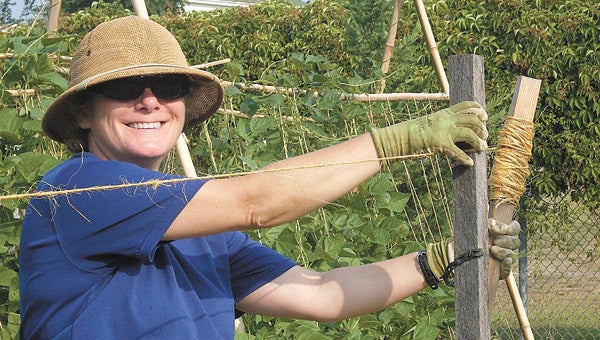A healthy table
Published 9:51 pm Saturday, August 28, 2010

Annette Kelly creates a “Florida Weave” to support the growing plants at East Suffolk Community Center Garden. Several Master Gardener trainees have been working in the garden, learning and earning their Master Gardener designation.
Partnership’s gardens encourage better eating
There is a lot that goes into leading a healthier life; among the most important things are plenty of fresh fruits and vegetables.
Experts say there is no substitute.
In its effort to make Suffolk a healthier place, the Suffolk Partnership for a Healthier Community is bringing health — by the basketfuls — to people around the city.
“There are nutrients in fruits and vegetables that go beyond vitamins A, B and C,” said the partnership’s Kay Cherry. “When we eat whole foods, we get things like antioxidants and phytonutrients. There are mitigating factors, but people who eat fresh fruits and vegetables live longer, healthier lives. We want the residents of Suffolk to have that.”
To help bring fresh fruits and vegetables into homes and teach residents how to grow their own, the partnership has established five community gardens, two of which are new this year.
The Holland, East Suffolk Recreation Center and Chorey Park Apartment gardens were already established, and new gardens at the Children’s Center and Kilby Shores Elementary School were planted this year.
“A large focus of ours this year is education,” Cherry said. “Output is still important, but we want to teach what healthy food can do for a person and what it looks like to grow it. We want to give the children the gift of knowing how to be self-sufficient and knowing how to build their own garden and what the fruits of their labor taste like.”
The students at the Children’s Center, with the help of the Driver Ruritan Club and Katie Humphrey, were able to harvest six cantaloupes and eight watermelons for snack time and green peppers for cooking.
At Kilby Shores, with the help of teachers Jill McGrath and Suzanne Stephenson, students were able to harvest a bushel of squash and half a bushel of cucumbers, which they sent to Neb Jones retirement community; and they expect to have a late crop of green beans and banana peppers, as well.
The Holland community garden brought in 70 pounds of cabbage and 25 pounds of broccoli.
“Their output would have been more, but the heat cut down lettuce and spinach,” Cherry said. “Something they did that was important in educating people about the health of vegetables was the canning class they had. They taught people how to preserve the vegetables they have.”
Also conducting a heavy education effort was the East Suffolk Community Center garden, led by Mike Kelly, which was able to donate more than 125 pounds of vegetables to the ForKids Suffolk House shelter, 15 pounds of tomatoes for the Holland canning class and four watermelons for the Extension office’s healthy eating program. Volunteers also hope to have 100 pounds of pumpkins to donate for a pumpkin-carving activity.
At the Chorey Park Apartment gardens, where the residents are volunteers and the output goes straight to their table, 125 pounds of produce and five watermelons were gathered.
“They’re also planning a booklet on how to teach people to prepare their fresh veggies,” Cherry said.
While the education and output of gardens lends to creating healthier community, the process of creating the gardens also contributes to that end.
“Gardening isn’t an armchair activity,” Cherry said. “You might not think about it, but anyone — from the children to the elderly — who is helping plant or harvest a garden is engaging in a healthy activity. You’re using your muscles and are in the fresh air. It’s teaching people to eat healthy, showing them how to eat healthy and they’re being healthy in the process. It’s a win-win-win situation.”
To find out more about getting a community garden in your area contact Kay Cherry at 446-6122.


